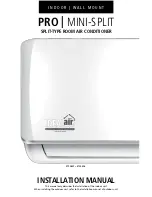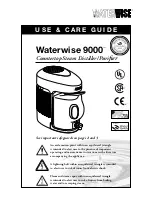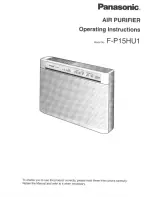
SERVICING
88
use one of the extra wires to connect the two 24 volt
commons together. This will ensure both 24 volt
commons are at the same ground potential.
•
When outdoor transformer is used and there are only
two thermostat wires running to the outdoor unit
ground the 24 volt common “C” of the outdoor
transformer to a chassis ground (earth0 ground. This
is not as good as the third wire but it is better than
leaving the outdoor 24 volt common floating.
If this does not resolve communication issues Bias switch
issues will need to be checked
.
Note:
Only one unit should control bias on the system.
•
Air Handler or Furnace should never have their bias
switches moved.
•
Indoor bias switches are always in the
“ON”
position
•
A/C and Heat Pump bias switches can be moved.
•
Thermostats do not have bias switches.
•
It may be necessary to move bias switches on the
outdoor unit to achieve proper bias. If the switches
need to be moved both switches must be moved.
Checking Bias Voltage:
Remove communicating wires from outdoor board and
thermostat and check voltage at the indoor board.
1.
DC voltage from C to data 1 should read approxi-
mately 1.9vdc or 2.8vdc for some furnaces. (Figure 1)
2.
DC voltage from C to data 2 should read approxi-
mately 1.3vdc. or 2.2vdc for some furnaces . (Figure
2)
3.
Difference in voltage should be .6vdc.
Figure 1
Figure 2
Reconnect communicating wires from outdoor
board check voltage again
1.
Check voltage from C to data 1 and C to Data 2 if the
voltage is different than the original reading listed
above. The outdoor bias switches must be turned to
off.
2.
Turn power off at outdoor unit and unplug the low
voltage connector.
3.
Remove the plastic film covering the switches with
screwdriver or knife.
4.
Turn both switches to “off” position.
5.
Plug in connector and turn on power and check DC
voltage between C and data 1 and C and data 2.
Difference should be .6vdc.
SEQUENCE OF OPERATION
AVPTC/MBVC with ASXC/DSXC Condenser and CTK0*
Communicating Themostat
The AVPTC or MBVC air handle/modular blower matched
with an ASXC or DSXC condensing unit and CTK0* commu-
nicating thermostat constitute a network. The three compo-
nents, or subsystems, making up the system communicate
with one another with information passed between all three
components. This leads to a somewhat non-traditional
manner in which the system components receive commands
for system operation. All system commands are routed from
the component through the network to the appropriate desti-
nation component.
NOTE:
The individual subsystems will cease operation if the
request for operation is NOT refreshed after 5 minutes. This
is a built-in safe guard to prevent the possibility of runaway
operation.
1.0 Cooling Operation - Low and High Stage Cool
1.1 The CTK0* thermostat sends a request for low stage
cooling through the network to the unitary (UC) control in
the condenser. The UC control receives the command
and processes any compressor and fan delays.
1.2 The UC control sends a request for low stage fan speed
















































